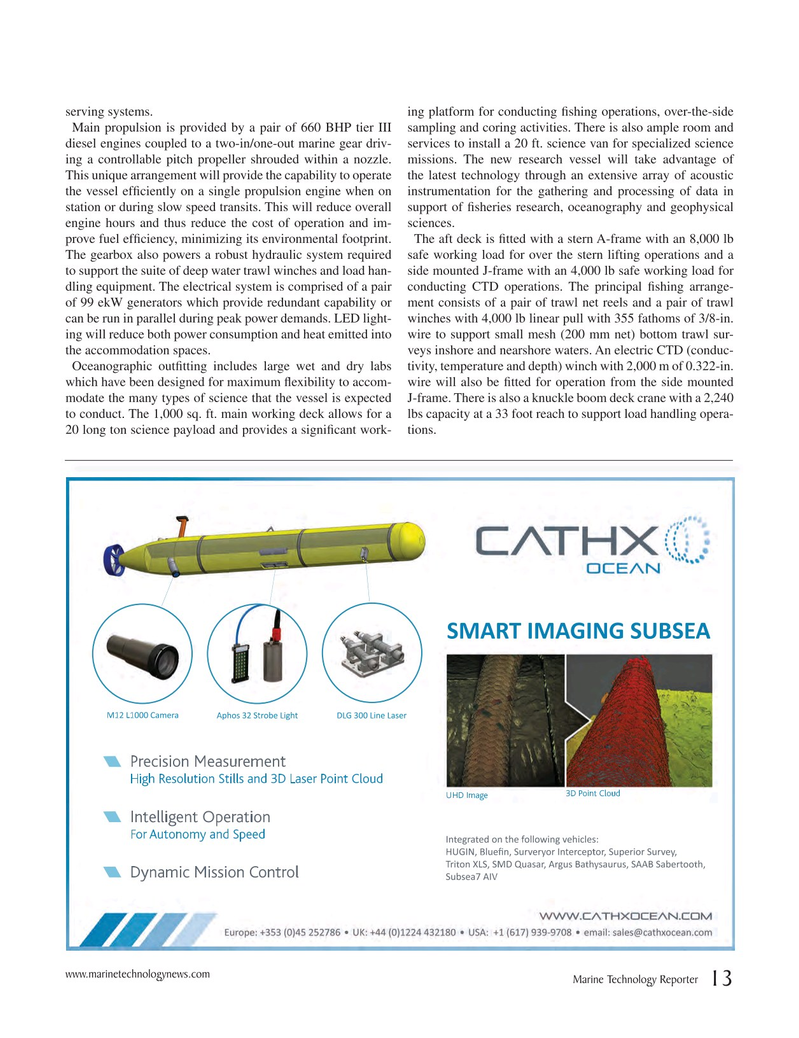
Page 13: of Marine Technology Magazine (January 2017)
Underwater Vehicle Annual: ROV, AUV, and UUVs
Read this page in Pdf, Flash or Html5 edition of January 2017 Marine Technology Magazine
serving systems. ing platform for conducting ? shing operations, over-the-side
Main propulsion is provided by a pair of 660 BHP tier III sampling and coring activities. There is also ample room and diesel engines coupled to a two-in/one-out marine gear driv- services to install a 20 ft. science van for specialized science ing a controllable pitch propeller shrouded within a nozzle. missions. The new research vessel will take advantage of
This unique arrangement will provide the capability to operate the latest technology through an extensive array of acoustic the vessel ef? ciently on a single propulsion engine when on instrumentation for the gathering and processing of data in station or during slow speed transits. This will reduce overall support of ? sheries research, oceanography and geophysical engine hours and thus reduce the cost of operation and im- sciences.
prove fuel ef? ciency, minimizing its environmental footprint. The aft deck is ? tted with a stern A-frame with an 8,000 lb
The gearbox also powers a robust hydraulic system required safe working load for over the stern lifting operations and a to support the suite of deep water trawl winches and load han- side mounted J-frame with an 4,000 lb safe working load for dling equipment. The electrical system is comprised of a pair conducting CTD operations. The principal ? shing arrange- of 99 ekW generators which provide redundant capability or ment consists of a pair of trawl net reels and a pair of trawl can be run in parallel during peak power demands. LED light- winches with 4,000 lb linear pull with 355 fathoms of 3/8-in. ing will reduce both power consumption and heat emitted into wire to support small mesh (200 mm net) bottom trawl sur- the accommodation spaces. veys inshore and nearshore waters. An electric CTD (conduc-
Oceanographic out? tting includes large wet and dry labs tivity, temperature and depth) winch with 2,000 m of 0.322-in. which have been designed for maximum ? exibility to accom- wire will also be ? tted for operation from the side mounted modate the many types of science that the vessel is expected J-frame. There is also a knuckle boom deck crane with a 2,240 to conduct. The 1,000 sq. ft. main working deck allows for a lbs capacity at a 33 foot reach to support load handling opera- 20 long ton science payload and provides a signi? cant work- tions.
www.marinetechnologynews.com
Marine Technology Reporter 13
MTR #1 (1-17).indd 13 MTR #1 (1-17).indd 13 1/24/2017 10:12:58 AM1/24/2017 10:12:58 AM

 12
12

 14
14
